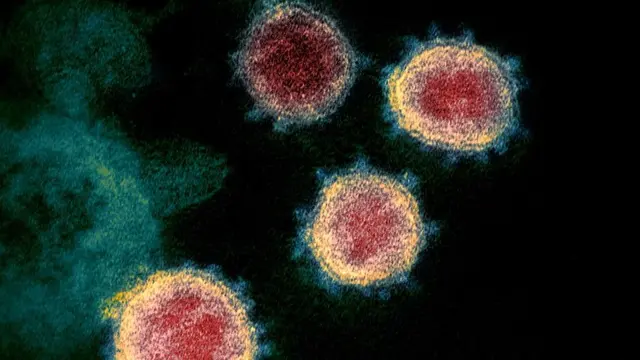
**Editor's note: **Ehizuelen Michael M. O. is Executive Director of Center for Nigerian Studies at the Institute of African Studies, Zhejiang Normal University. The article reflects the author's opinions and not necessarily the views of CGTN.
Since the COVID-19 epidemic broke out in late January, the Chinese government has taken the most comprehensive and strictest measures to control and prevent the epidemic. Now one month on, the dwindling number of infected people in the country is proving these measures have been taking effect.
During this period, the Chinese government branch in charge of the epidemic prevention, medical institutions and over 20,000 medical and health professionals, as well as medical researchers from around the nation, have joined hands in optimizing the epidemic control strategy, and large quantities of medical supplies have been made to step up research and development of medications as well as patient treatment plans.
There were other several unconventional measures adopted thus far – such as rushing medical staff and other resources to Wuhan, which until the outbreak was well-known as the City of Light and Happiness, assigning 19 provinces or municipalities to help treat severely ill patients in a specified area in Hubei, work-from-home arrangements, calling for the public to stay at home unless necessary and the continuous inflows of several national resources such as the "super-fast hospital" building.
In terms of financial support, China's central bank announced on February 10 that it planned to provide loans of about 43 billion U.S. dollars to policy and commercial banks via the re-lending program to finance companies that are directly involved in fighting the COVID-19 outbreak. More so, Hubei authorities introduced
17 favorable policies
on February 2 to give backing to the fight against the COVID-19, including tax cutbacks for businesses providing essential items during this period of time, subsidies for medical staff working on the front lines and staff working overtime in medical manufacturing firms, vegetable growing firms, cooperatives, supermarkets and rural markets to make sure that there is no severe shortage of daily necessities in Hubei.
What is also remarkable is that not only is the government instituting policies to fight the outbreak, various Chinese tech giants like Tencent, Alibaba, Baidu, ZTE, iFLYTEK, and JD.com have also joined the battle. They are actively employing as well as exploring how emerging technologies such as big data, artificial intelligence, and 5G in long-distance diagnosis, screening, as well as medical services can be applied to help combat against the COVID-19.

Additionally, the Chinese government adopted an open and transparent as well as highly responsible attitude. This was done not only for the sake of the Chinese people, but the world as well. More so, kudos to a well-timed Chinese government as well as the people that applied a well-organized social mobilization system and rigorous prevention and control measures that far surpass the requirements of the global health regulations, effectively curbing the spread of the COVID-19.
This is a testament that the strengthened Chinese medical system can be a great asset in enabling the world to tackle and manage such an outbreak in the future. Speaking of the future, I firmly believe that the ongoing fight against the COVID-19 can lend many lessons, much enlightenment and inspiration to both China and the international community for fighting pandemics in the future. China's broadened diagnosis criteria to control the epidemic further reflects the nation's enhanced diagnostic capacity as well as the principle of "leaving no one unattended or under-attended to."
As such, the Chinese government highest-level prevention and control measures have proven quite effective and have started to pay off as the COVID-19 has been brought under control with growth rates of confirmed infections, suspected cases, and patients under medical observations are all in a steady deterioration. Specifically, newly confirmed cases in places other than Hubei have been on the downward trend since February 3, with the number dropping to a single digit in the past two days.
Notably, each day since February 7, 2020 has seen some 500 patients walk out of the hospital after recovery. In Zhejiang, Shandong and a few other provinces, the number of cured patients has even started to exceed that of confirmed cases. With a deeper understanding of the COVID-19 and enhanced effectiveness of medical treatment, the number of cured patients has kept soaring – from 34 by January 23 to nearly 40,000 by February 29 nationwide. Besides, as of February 29, the number of cured patients has surpassed that of patients who remained infected.
So, with the above encouraging statistics as well as unremitting efforts, particularly with the continuous development of effective drugs, China should not be distracted by the sideshows of those who neither have interest nor responsibility to safeguard the safety and well-being of the Chinese people as well as the global community. This is because, at present, what matters most is the battle to safeguard human health, mutual understanding, trust and support across national borders.
Therefore, instead of capitalizing on the adversity to spread hate, we should use our time, resources, energy and platforms to disseminate the message of hope and not panic.
Some of the racism-implicit (and occasionally explicit) responses towards the Chinese folks so far have made me wonder how far the world has truly come as a human family. The COVID-19 should be a time of international solidarity that can create an opportunity for the world to share their acts of kindness to fight against the epidemic, which is the world's common enemy, as well as to enhance the sense of a community of shared future for mankind.
(If you want to contribute and have specific expertise, please contact us at [email protected])
 简体中文
简体中文





